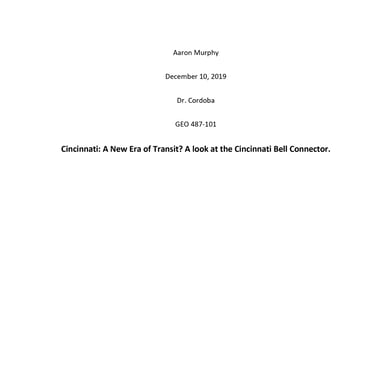Cincinnati: A New Era of Transit? A look at the Cincinnati Bell Connector.
This project was for Transportation Geography / GEO 487 at Marshall University
Cincinnati has had a long history with in developing public transit – as the widespread use of the streetcar developed in the late 1800s; alternatives to this began to be developed to increase the rapid movement of peoples. Beginning in the early 1910s an underground subway was proposed and underwent construction – the populace was in favor of the development; it would, however, go unfinished after funds for development went dry and the project was ultimately abandoned. This abandonment is still present in the minds of the local population today and in fact has been used to publicly to denounce the development of the current streetcar that began to run in late 2016. In the lead up to this development several obstacles stood in the way of development; public opposition was intense, and it led to a series of referendums on the ballot in 2009 and again in 2011. The referendum in 2009 was an attempt by the opposition to stop the city from going forward by blocking funds; it ultimately failed by a margin of 56.18% to 43.82%. The opposition tried once more in 2011 which led to a much closer vote, but it once again failed 51.8% to 48.2%. The previous mayor of Cincinnati, Mark Mallory, was a strong supporter of the system and as mayor he led the development of the project. Mark Mallory left office in 2013, and incoming mayor John Cranley was in opposition to the streetcar and felt that funds could be better utilized elsewhere. Since its inception ridership had faced significant declines from the original operation, although recently it has begun to gain in ridership; it is important to take a look at specific measures to gauge the success of the Cincinnati Streetcar (known as the Cincinnati Bell Connector). It is possible to gauge the success by looking at the ridership over time, changes in local populations, and movement of home/land values.

